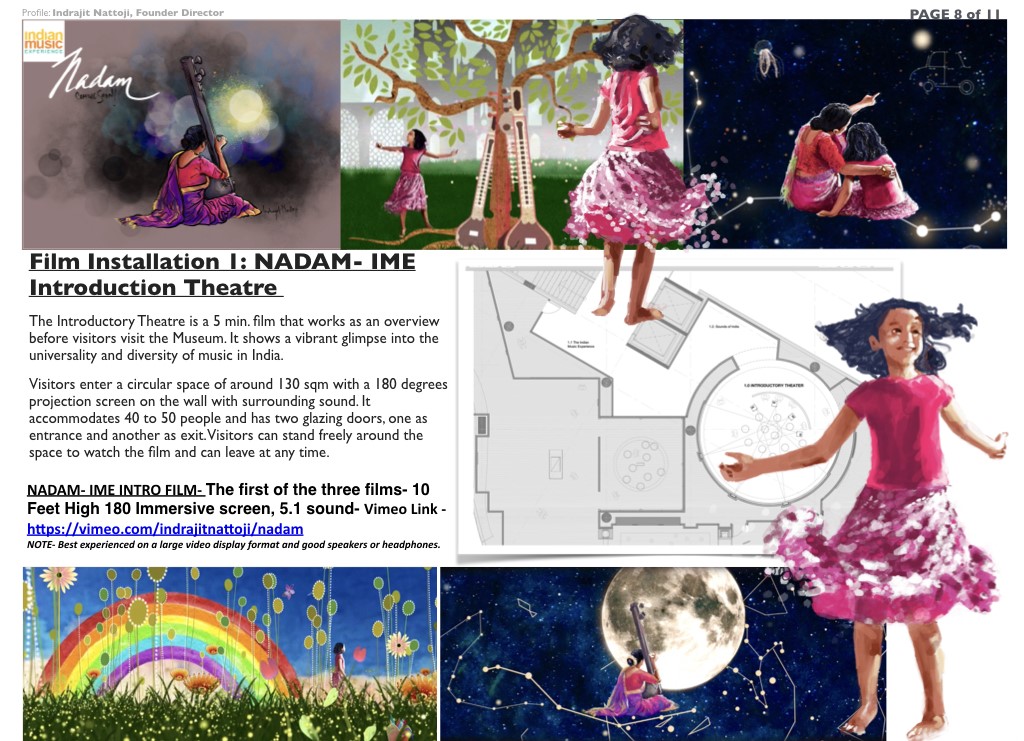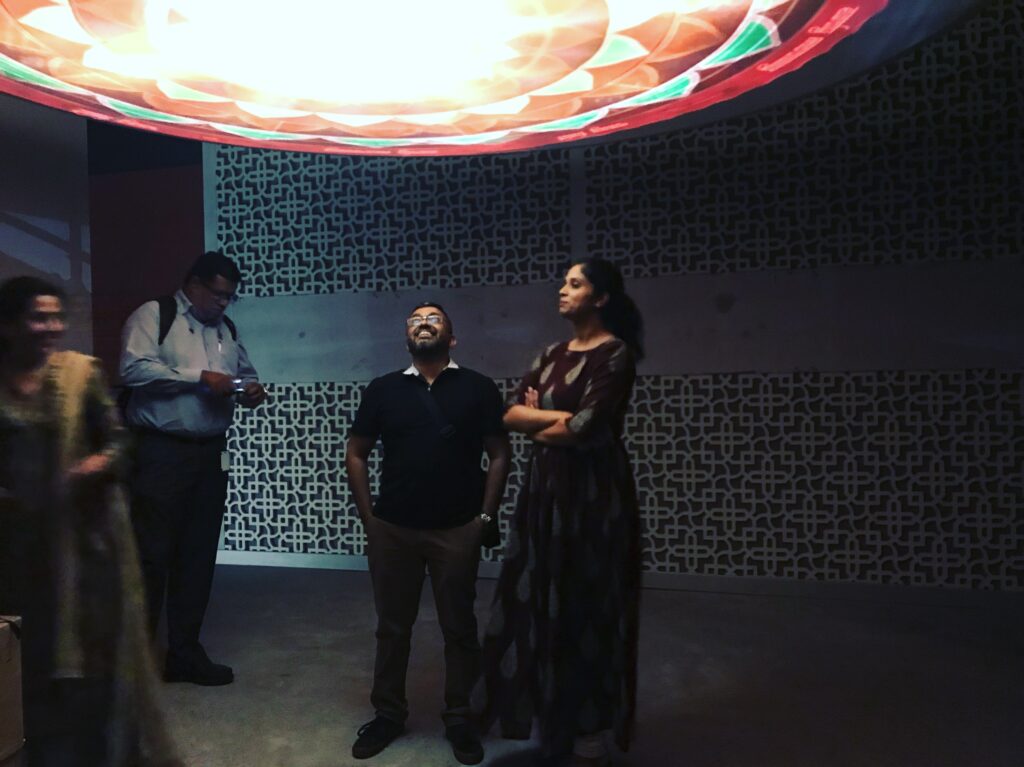Nadam (Sound), an experiential introductory film for the Indian Music Experience (IME), India’s first permanent interactive museum of Indian Music, recently fetched international recognitions. Filmmaker Indrajit Nattoji, the man behind this unique blend of music and art in this marvellous digital extravaganza, talks about how he explored the vast world of Indian music in this immersive experimental work of animation.
The exquisite animation for Nadam is done by Upasana Nattoji Roy and her team at Switch Studios, with the musical universe created by Gaurav Chatterjee, the lustrous sounds designed by the late Anish Gohil and co-written by Santayan Sengupta, a fellow designer and musician. Lastly, the characters were artistically rotoscoped and hand-painted by Indrajit himself while wearing different hats of creative director, producer and cameraman.
The second film installation for IME is Samay Chakra, a looped overhead projection showcasing the different Hindustani classical ragas or musical tempers in the 24-hour time cycle. Each Raga musically symbolises the mood of the respective times in a day, from morning to night.
During an interview with Animation Xpress, the director shared that after the museum reopened post pandemic, several film festivals noticed the film Nadam online, and the film was invited to participate. Tokyo International Short film fest was one of them where it won honourable mention in the best short film category! Nadam is also the award-winner and nominee in three categories at the Indie Short Fest 2022 (Los Angeles International Film Festival). It also features in the official selection list of 12th Dada Saheb Phalke Film Festival-2022.
“Nadam is one of the three film installations for IME, produced by my company, Blink Pictures. The Film Project came as a breath of fresh air when I was already bored of advertising, and it pushed me to get back to my roots of art and painting, which I had let go of over the years. The unique and challenging film formats and the vastness of Indian music as a subject made me feel like a design student all over again,” Indrajit said.
Such beautiful ideas often emerge from something special and that is close to the artists’ heart. In line with drawing inspiration from one’s own life, Indrajit’s story gained momentum from his real life and family, the characters being based on his little daughter Nandini and wife Nandita. Nandita has also voiced the film.
“I grew up in a household where music and art were essential aspects of daily life, and this project was an opportunity to explore and amalgamate both. The film is for my late mother, who originally introduced me to this beautiful journey of music. Nadam, designed to play in a 180º immersive circular projection, showcases a vibrant glimpse into the uniqueness and diversity of the Music of India. The story is of a young girl (Shruti) who wakes up disturbed and scared by the sounds of the night. Her mother comforts her and shows her that every sound is a musical note. She then proceeds to take Shruti on a beautiful audiovisual journey, showcasing the diverse origins and the eclectic evolution of Indian Music,” he revealed.
The brief for Nadam was to create an introductory film for the Indian Music Experience Museum. He mentioned that when he received the brief, he pondered on how to encapsulate a millennium of Indian music spanning folk, classical, film and more that too in five minutes and where does one even start.
Talking about the roadmap he followed, the National Institute of Design alumnus said, “I started with the fundamental element of music, sound. Every sound is a musical note, and the arrangement of musical notes makes a melody that creates a musical composition and so on and so forth. And I planned to tell this story simply as an enthralling bedtime story for a child. I decided to narrate this with animation art, a mixed medium, with which one can create an abstract visual soundscape to showcase an eclectic journey of the evolution of Indian music. I wrote the story idea and created a mood board, and the IME team loved the idea. My muse was my then eight-year-old daughter, who plays the young Shruti in the film. I went on to do a few animatics of her sleeping and waking up with some quick sketches while fleshing out the story and script with Santayan, my writer. I then created a detailed storyboard with my animator, Upasana (Roy).”

After this, once the IME team was on board with the scripted storyboard, Gaurav, the music director, and Indrajit made a ‘radio edit’ of the voice, rough sound design and music – much like a ‘sound-board’. This gave them an idea of the sonic graph of the film.
According to him, Manasi Prasad, museum director of IME, has been more of a collaborator than just a client. “She has been with the museum project from its inception, much longer than I. Her passion and dedication to Indian Music and the museum are infectious.”
Sharing the technical nitty-gritty, he said, “I then shot the characters of Ma and Shruti and edited the sequences of character action clips while the visual soundscape of the film was being designed simultaneously. I created stylised hand-painted animated characters with the edited action clips. Upasana and Switch Studios’ animation and VFX team visualised and put all the elements together and created Shruti’s ‘soundverse’. The music and sound design were then produced once the animation was locked.”
He further mentioned that, “We had done a reference radio edit of a sonic graph of the film based on the storyboard, but the actual sound design for Nadam was constructed once the animation was complete. Gaurav created set pieces of sound, with each mood piece transitioning seamlessly into the next one. Anish, the sound designer, then orchestrated the sound effects and ambience for the visual sequences and music. The ultra-widescreen format meant that we needed to guide the viewer on which part of the screen to focus at various critical moments of the film. This we did with the 5.1 Surround Sound mix, where one can pan the audio elements and place them in a particular virtual sonic space and make the audience turn their heads to the right point of view.”
Their effort was all worth it when the work was finally projected on the 100 feet screen in the museum theatre with surround sound. It was indeed a magical journey of music and art.
Nadam combines traditional hand-painted animation created on Procreate with composited 2D backgrounds and landscapes created with Adobe Photoshop and animated with Adobe After Effects. The massive 6990 x 1200 pixels format for a 100/10 feet projection screen put forth a formidable workflow and render time challenge, as Indrajit believes there were more than 100 layers that team Switch Studios was grappling with on After Effects. There was no precedent for a film in a format like this, and one had to solve a lot of the technical issues by trial and error, common sense and sometimes just by winging it.
It is interesting to note that the characters of Ma and Shruti have been digitally hand-painted frame by frame from edited live-action clips, a technique that can be called ‘artistic rotoscope’. Some textures and sketches were also done on paper and scanned for the backgrounds.
“We realised that any cinematic cut would visually jar within such an unconventionally large widescreen format as the projection exceeds the audience’s cone of vision. Due to the constraints of the theatre space, the viewer needs to pan one’s head to take in the visuals. Therefore the edit of the film needed to have seamless transitions between the set pieces so that each sequence segues into the other to create a frictionless audiovisual experience. This discipline was integrated into film, animation, and sound design,” he mentioned about the final edit of the film.
Nadam was completed in 2019. After previews and technical tests onsite at the museum, it premiered at its grand opening in July 2019. Unfortunately, soon the pandemic struck, and not many could see it at the museum theatre.
“Now that the museum is open, I hope more people see it at the introductory museum theatre in its full glory projected on the massive 100 feet curved screen with immersive surround sound. It is definitely not designed to be viewed on a laptop or a phone,” he exclaimed.
His second work for IME is another marvellous piece.
Samay Chakra installation theatre is a 360-degree overhead projection casting the audiovisual image vertically onto the horizontal hanging circular screen so visitors can experience the film looking up. The film is a looping video for visitors to watch a portion or the entire duration. The viewer experiences the changing of scenery (from day to night and back to day again) and the associated Hindustani classical music ragas for different times of the day. Associated imagery includes animated elements from Raga mala paintings – Indian miniature artworks depicting Hindustani music ragas.
“The film, created in a circular format, is a visual amalgamation of live-action time-lapse shots of landmarks and landscapes of North India, animated elements of Ragamala paintings, and Mandalas. I visualised the layered composites to represent the passage of hours, days, seasons and cosmic time and space,” Indrajit explained.
The animation for this film was executed by motion graphic artist Vishrut Manseta.
Explaining how the Ragas have been used to blend with time in creating a transcending experience, he said, “My brief for the music to eminent flautist Pravin Godkhindi was a single loopable track with different ragas blending seamlessly. This was a challenging music composition as each Hindustani classical Raga has its own individualistic persona and mood. The continuously looping, visually rich, circular projection with a captivating soundtrack represents an endless wheel of time, creating an immersive and experiential installation – The Samay Chakra. The viewer also can read up on Hindustani classical ragas in panels around the area.”
Asked about the future of Indian animation in terms of creativity, Indrajit said, “The investment of time and effort required for an animated film project is tremendous and needs patronage and funding to sustain the complex production and team requirements. In the post-pandemic era of quick turnarounds and instant return on investments, studios and production houses in India don’t see animation projects as viable. Therefore animation remains a non-mainstream activity in India, often reduced to fast to cook animated cartoon series on TV. Consequently, creativity is limited to independent filmmakers and artists who love the medium and have exciting stories to tell with their fantastic animated shorts. At the same time, the big Indian animation studio spots get more mediocre, chasing TRPs and numbers.”
The filmmaker concluded by sharing that he’s currently working on the third installation known as Filmy Geet for IME. The film will be showcasing the process of creating a Bollywood song.

